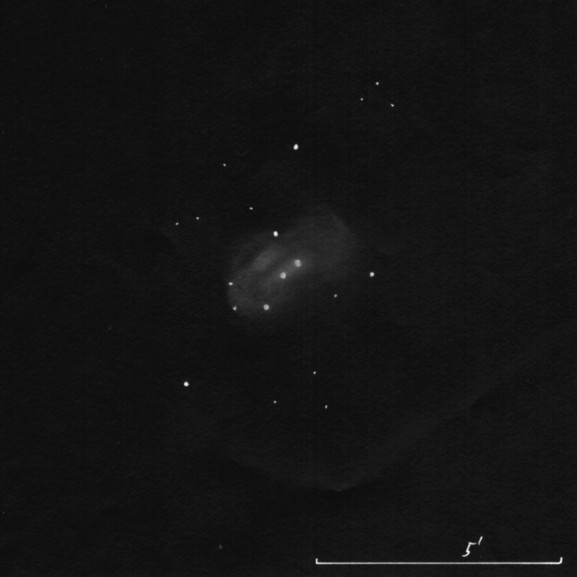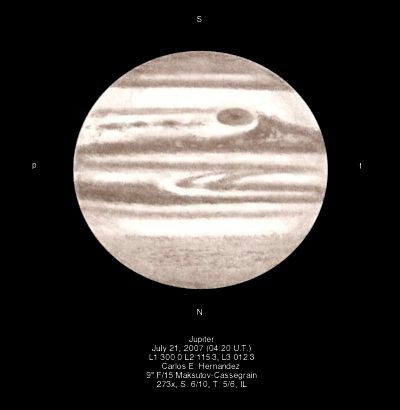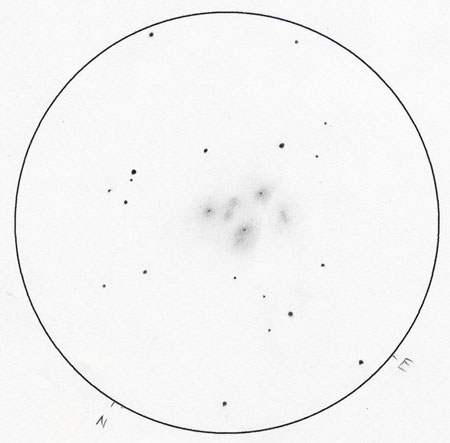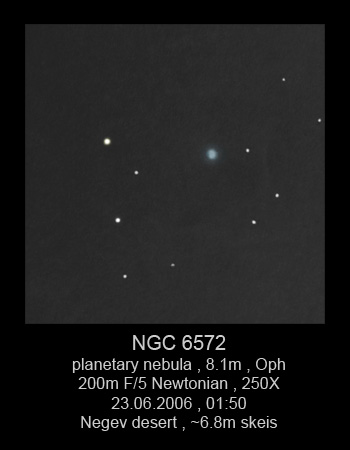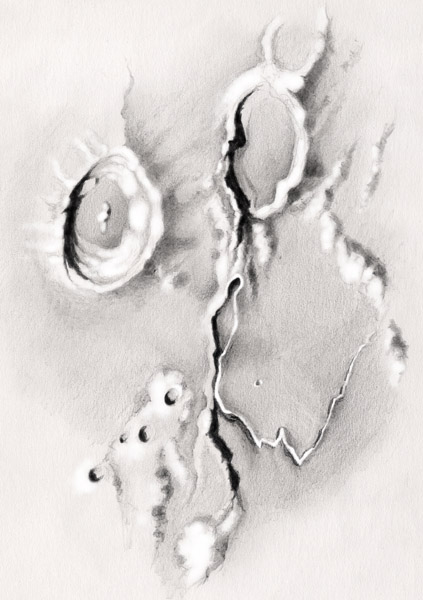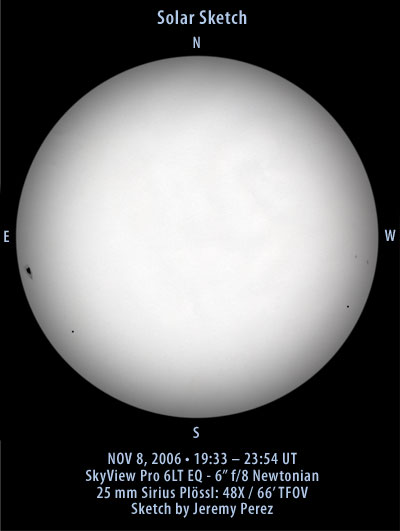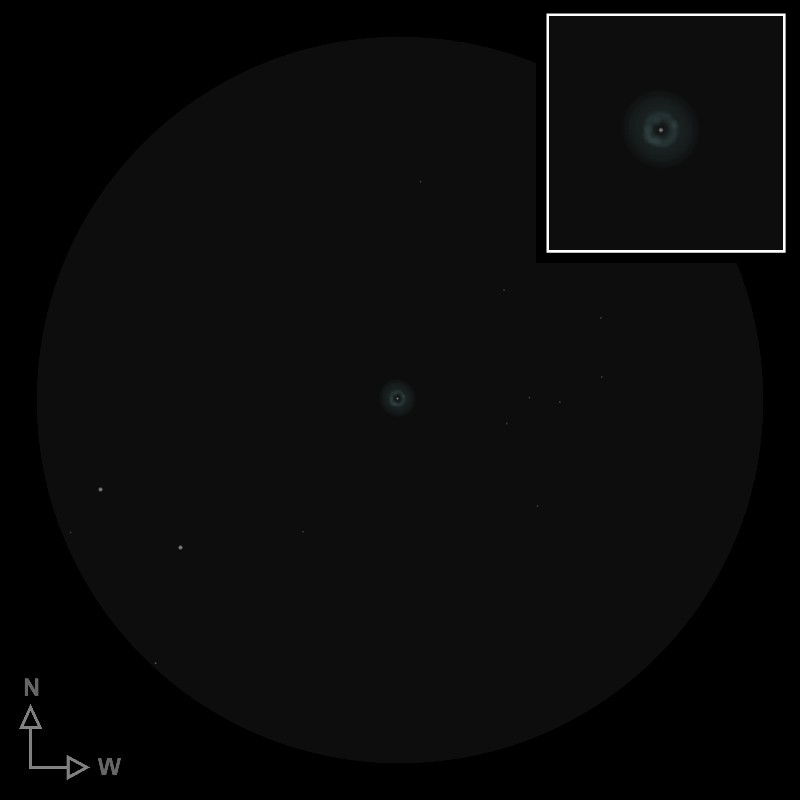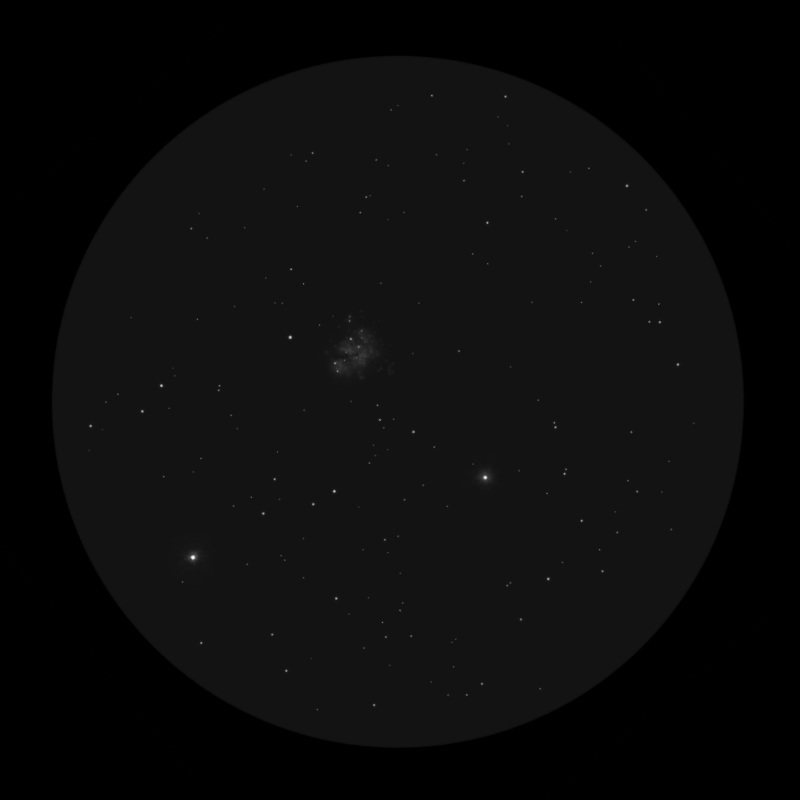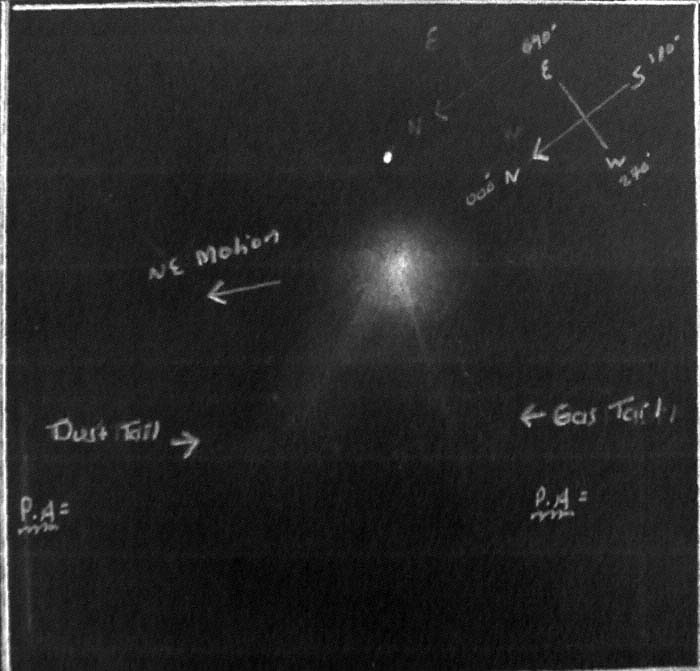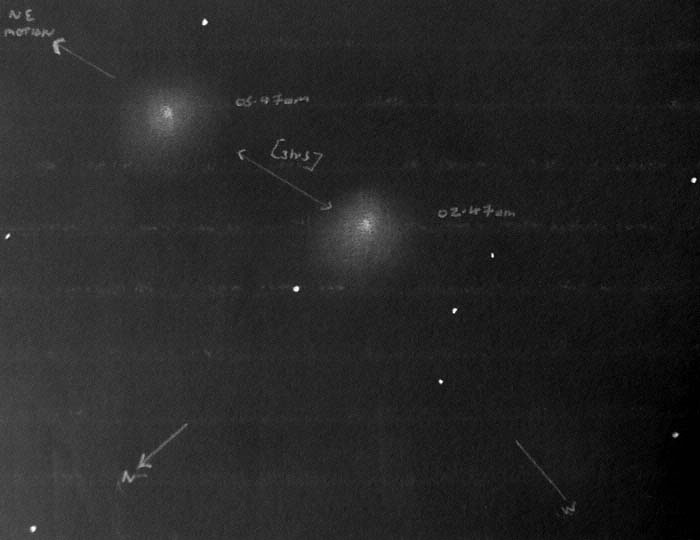NGC 6300
Sketch by Eiji Kato
Category: Pencil
Last Summer’s Jupiter
Jupiter
Sketch and Details by Carlos E. Hernandez
Date (U.T.): July 21, 2007
Time (U.T.): 04:20
L1 300.0, L2 115.3, L3 012.3
Instrument: 9-inch (23-cm) F/15 Maksutov-Cassegrain
Magnification: 273x
Filters: None (IL)
Seeing (1-10): 6, Antoniadi (I-V): III
Transparency (1-6): 4-5
Notes:
South Polar Region (SPR): Appeared dark to dusky (3-4/10) and mottled.
South Temperate Zone (STZ): Appeared thin and bright (7/10).
South Temperate Belt (STB): Appeared thin and dark to dusky (3-4/10). No ovals noted at this time within it.
South Tropical Zone (STrZ): Appears bright (7/10) and contains the Great Red Spot (GRS) and a dull (5/10) band following the GRS.
Great Red Spot (GRS): Appears dusky to dull (4-5/10) with a dark (3/10) center. I was unable to time it as a tree blocked my view.
South Equatorial Belt (SEB): Appears irregular, especially preceding the Great Red Spot (GRS). The portion of the SEB preceding the GRS appears dark to dull (3-5/10) over it’s northern half whereas dusky (4/10), isolated condensations are noted along the typical southern border of the SEB. The SEB following the GRS appears dark to dusky (3-4/10) containing bright (7/10) ovals/rifts within it.
Equatorial Zone (EZ): Appears shaded to bright (6-7/10) and contains a band (EZB) across it’s midsection. Blue festoon projections (from blue festoons along the NEB-S) are also noted within it.
North Equatorial Belt (NEB): Appeared dark to dusky (3-4/10) with a bright (7/10) rift originating preceding the CM (over the southern border) and extending towards the following limb. Two blue festoon bases were noted along the southern border of the NEB.
North Temperate Belt (NTB): Appears north of the NEB as broad, dusky (4/10) band.
North Polar Region (NPR): Appears dark to dull (3-5/10) and mottled.
Hickson 70
Hickson 70
Sketch and Commentary by Bill Ferris
Move cursor over image to see labels.
Hickson 70: Galaxy Cluster (Canes Venatici)
RA: 14h 04.2m / DEC: +33º 20′.3
Instrument: 18-inch Obsession
Hickson 70 resides in far eastern Canes Venatici. The magnificent M3 can be found just 7 degrees to the southwest. But this cluster presents more challenging fare. My sketch combines 199X and 272X views in the 18-inch Obsession. Seven member galaxies in this tightly-packed cluster are visible. Hickson 70A is cataloged as UGC 8990 (=MCG +06-31-59, PGC 50139) and is often misidentified as IC 4371. The 16.1(B) magnitude galaxy resides at 14 hrs., 04 min., 10 sec,; +33 deg., 20.3 minutes and is nearly centered in my sketch. It features a stellar core and covers a 0′.7 by 0′.3 area. Hickson 70D (=IC 4370, MCG +06-31-60) appears as a tiny, 16th magnitude smudge along the northern edge of Hickson 70A. About 2′ to the south, Hickson 70B (=IC 4371, MCG +06-31-61, PGC 50140) displays a stellar core embedded within a 0′.5 by 0′.3 oval glow. 11.0 magnitude SAO 63918 simmers another 2′.3 to the south. The thin sliver of light 2′ to the east of Hickson 70B is MCG +06-31-064. This 16.2(B) magnitude galaxy covers a 0′.5 by 0′.2 area and is aligned northeast to southwest. Three galaxies are grouped to the southwest of Hickson 70A. These include 16.2(B) magnitude Hickson 70E (=IC 4369, MCG +06-31-58, PGC 50134), 17.3(B) magnitude Hickson 70F (=MCG +06-31-57, PGC 50133), and 17.4 magnitude 2MASX J14040011+3319540. Hicksons 70E and 70F are very close to each other and just 1′.3 southwest of Hickson 70A. High magnification was needed to consistently separate the two.
The Emerald Eye of Ophiuchus
NGC 6572
Sketch by Michael Vlasov
According to Stephen O’Meara’s Deep Sky Companion’s, NGC 6572 is 1.5 magnitudes brighter than M57 and five times smaller. This makes for a bright, and as many discover, colorful planetary nebula. Wilhelm von Struve discovered it in 1925 and described it as one of the most curious objects in the heavens, ” a star surrounded by a bright green ellipse of fuzzy light.”
The Cobra’s Head
Vallis Schroteri
Sketch by Serge Vieillard
Vallis Schröteri is the largest sinuous valley on the Moon. It makes its start at a 6 km diameter crater just north of Herodotus crater and widens to 10 km. This area is sometimes referred to as the Cobra’s head. It then winds 160 km and narrows to 500 m at it’s end. The rille is likely the result of volcanic activity as a lava flow carved its winding path through the landscape.
A Freckle on the Sun
Mercury-Solar Transit
Sketch and Commentary by Jeremy Perez
Move cursor over sketch to see labels.
On Wednesday, November 8th, 2006, Mercury was due for a solar transit. Now, in my neck of the woods, that just happens to be a work day. So I planned to set up the scope during lunch in the parking lot, or outside the lunchroom. The only thing I needed was a solar filter. A couple years ago, a very kind and generous amateur astronomer from Phoenix, Scott Kroeppler, sent me a couple small Baader solar film samples. Other than some casual, unmagnified looks at the sun, I hadn’t put them to good use. Until now. I stayed up the night before, rigging these two 1-inch square pieces of solar film and a sewing hoop to an 8 inch square piece of foam core. I wasn’t sure if it would work, but the next morning, I pulled into the parking lot at work, put my mangy, home-made solar cap on the front, and got a handheld look at the sun for the first time through my own scope. Not only did it work great, but I was pleasantly surprised to see a huge sun spot easing over the solar limb.
So I got to work, and then about 15 minutes before the beginning of the transit, I put it all together on the patio outside the lunch room where I had the best opening between all the trees. I didn’t start quite early enough, because by the time I got everything set up and the solar cap taped on securely, Mercury was already well inside the solar disc. It looked just like a printed period against blue-white filtered circle of the sun. It had entered just south of the massive sunspot I noticed earlier. A couple fainter sunspots rested on the opposite side. At that point, I made my first solar sketch, and noted how easy it would be to really exaggerate distances and proportions across the sun’s face. I was excited to see that light, textured, filamentary features were visible around the sunspots. As I studied these features, I noticed that it didn’t take long for Mercury’s motion to become apparent.
Over the next 45 minutes, I invited passing coworkers to have a look. They all seemed happy to get a look at the transit, particularly after reading about it in the newspaper the day before. As folks walked up to the eyepiece, I tried to coach them a bit with the sketch to be sure they didn’t confuse the sunspot for Mercury. Quite a few commented on how very tiny the little planet appeared. Several of them were even able to make out the two relatively faint sunspots over on the western limb as well. After a little more than an hour, I moved the scope to an out-of-the-way spot, and went back to work.
At about 20 minutes before the end of the transit, I raced outside to find that the sun was completely hidden behind trees where I had the scope set up. With a bit of scouting, I moved the whole thing into the parking lot about a hundred yards to the north where I had a clear vantage. And here I got to watch that perfect little dot edge closer to the western edge of the sun. At about four Mercury diameters from the edge, the whole shebang began to sink behind a tree-lined ridge a mile to the west. So I missed seeing Mercury merge with and disappear into the darkness on the other side of the sun. It was still a fascinating event to witness, and since Mercury won’t do this again until 2016, I’m glad I was able to fit it in.
The sketch at the top of this post was overlayed onto a digitally generated disc with limb darkening that estimates what I saw through the eyepiece. The next time I sketch the sun this way, I’m sure I’ll want to include the lighter features, which will mean generating that limb darkening manually and erasing through it.
| Subject | Mercury – Solar Transit |
| Classification | Planetary/Solar |
| Date/Time | November 8, 2006, 12:33 – 04:54 PM MST (November 8, 2006, 07:33 – 11:54 UT) |
| Observing Loc. | Flagstaff, AZ |
| Instrument | Orion SVP 6LT Reflector (150 mm dia./1200 mm F/L) |
| Eyepieces/Mag. | 25 mm (48X) |
| Conditions | Clear, breezy |
| Seeing | Ant. IV |
Gazing into Cleopatra’s Eye
NGC 1535
Sketch and Commentary by Eric Graff
NGC 1535
Planetary Nebula in Eridanus
Parks Astrolight EQ6 • 6″ f/6 Newtonian Reflector
7.5mm Parks Gold Series Plössl + 2x Barlow • 240x
Field of View 13′
Lumicon OIII Filter
31 December 2007 • 04:30-05:15 UT
Secluded in an out of the way region of meandering Eridanus, the planetary nebula NGC 1535 is lost in a world of its own, far from any conspicuous guide stars. It is unfortunate that such an exceptional object languishes in relative obscurity; it is, arguably, the finest deep-sky wonder to be found on the shores of the celestial river. I found this hidden treasure by centering my scope on 5th magnitude 39 Eridani (the brightest speck of light within a triangle formed by Gamma, the Omicron1,2 pair, and 53 Eridani) and sweeping 2½° due south.
At low to moderately high magnifications NGC 1535 appears as a slightly out-of-focus blue-green star of about the 9th magnitude. It is this low-power aspect that has earned it the moniker “Ghost of Neptune”. In the low-power, wide-field ocular the planetary is situated near the center of a ragged semi-circle of 8th-11th magnitude stars with a radius of about 30 minutes of arc.
To understand NGC 1535’s other nickname, “Cleopatra’s Eye”, you’ll need to push your scope to the higher magnification ranges. I used a 7.5mm Parks G.S-5 Plössl coupled with a Parks G.S. 3-Element 2x Barlow for a magnification of 240x in making the sketch presented here. Magnifications above 200x are generally required to separate the 12th magnitude central star from the bright inner ring. This ring is somewhat irregular, about 20″ across, slightly brighter on the eastern side, darker in the middle and surrounded by a faint, diffuse outer envelope to a diameter of about 45″ and elongated slightly toward position angle 35°.
Sir William Herschel discovered NGC 1535 on February 1, 1785 with his 18.7-inch reflector. The expansion velocity of the outer atmosphere of this dying star has been measured at 19 km/sec. NGC 1535 lies at a distance of about 5,200 light years; it actual diameter is about 1.2 light years. It is five times further away and 3 times larger than the famous Ring Nebula (M57) in Lyra.
A Wide Look at M35
M35
Sketch and Commentary by Rony De Laet
While Gemini is far past its optimum appearance in the sky, the view of M35 is still very exciting in a pair of binoculars.
The open cluster M35 was probably discovered in 1745 by Philippe Loys de Chéseaux. In 1764 Charles Messier added the object in his famous catalog with the entry number 35. The cluster has once been called the Shoe-Buckle Cluster for an evident reason. This misty patch can easily be found at Castors foot, between Eta and 1 Geminorum. At a distance of 2.700 l-y, M35 is visible as a mottled, misty patch to the naked eye under very dark skies. It shines with a total magnitude of 5.1.
M35 is a very rewarding object in small binoculars. Once Eta Geminorum is centered in the field of view, the sparkling cluster is easily visible near the western border of the field. I could partially resolve the cluster with my 8×56. Four stars were visible with direct vision, while a total of 14 stars could be picked out of the glow with averted vision. A few dark lanes were visible as well. Unfortunately, the sky was not very clear during the observation and M35 was approaching the north-western horizon. I saw a brightening near the position of NGC 2158, but I could not confirm its presence. M35 is certainly an object to return to next year, when it appears again near zenith. The bright star near the bottom left corner of the sketch is Eta Geminorum.
Observing data:
Date : April 7, 2008
Time : around 20.30UT
Binoculars : Bresser 8×56
FOV: 5,9°
Filter : none
Mount : Trico Machine Sky Window
Seeing : 2,5/5
Transp. : 2,5/5
Nelm : 4,8
Sketch Orientation : N up, W right.
Digital sketch made with PhotoPaint, based on a raw pencil sketch.
McNaught-Hartley in Motion
C/1999 T1 McNaught-Hartley
Sketch and Commentary by Martin Mc Kenna
The top sketch shows C/1999 T1 Mc Naught – Hartley on Jan 14th 2001 at 06.30 LT low in the eastern pre dawn sky between Libra and Serpens in the 8″ F/10 S.Cass at 77X. Despite frozen mist, a harsh ground frost and a moon 4 days after full I could see this 8th magnitude comet quite easily and even picked out two tails, one of gas and one of dust.
The 2nd sketch shows the comet on Feb 25th 2001 at 05.47 LT in Hercules at magnitude 8.8. The sketch shows the comets NE movement over a 2 hour period.
This comet is very special to me as during Dec it was moving from the southern hemisphere into the northern hemisphere and I was desperate to see it. I tried to located it on every clear night even when the moon was full hoping to catch the comet as cleared horizon obstructions however despite trying so hard I could not get low enough in the eastern sky. The pre dawn hours of Christmas morning were cold, sharp with heavy snow on the ground and the corrector plate was threatening to freeze over at any moment. I guided the 8″ into the low eastern sky and began a hunt for new comets. 5 Minutes later as I swept through the southern section of Libra that was just rising over my neighbours rooftop and I found the comet! I was delighted beyond words and it felt like this comet was my Christmas present from the sky. I followed this icy wander on every clear night for months afterward as it moved from the morning sky into the evening sky. Mc Naught – Hartley taught me alot about observing comets, the long hours spent watching this comet have benefited me greatly with the future comets I have encountered.

